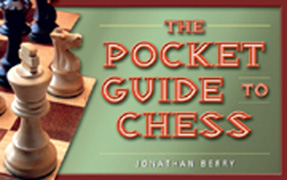

Chess has had more written about it than all other games combined; thousands of works already exist, and the chess enthusiast is inundated with a flood of new books appearing on an almost weekly basis. One recent addition is The Pocket Guide to Chess, written by our own Jonathan Berry and published by Master Point Press of Toronto. But considering the chess literature that already exists, is there a place for this book in the current market? Does it fulfill a need which has previously been unmet?
Happily, the answer to both these questions is "yes!" Designed as a ready reference work, "This book is a concise but complete survey of every aspect of the game of chess: a great first book for the beginner, and a useful reference for the intermediate player" (from the back cover). Berry does not cover such areas as the use of computers, thought processes, how to improve, or chess history, but deals strictly with the mechanics of playing a game of chess. The book is divided into eleven chapters, plus a glossary and index of openings. The first three chapters present the laws of chess and a description of chess notation, all pithily presented and illustrated. Chapter one compresses the FIDE rules of play into just two pages, including an impressive diagram with examples of all the standard moves. The second chapter ("Gotchas") is probably the most important for a beginner or casual player, as it explains situations where a detailed knowledge of the rules is necessary, e.g., castling, en passant, claimed draws, etc.
Chapter four is titled "Endgame Checkmates," but this is a bit of a misnomer. The bishop + knight mating procedure is discussed in some detail, but mating with king + queen or king + rook is not illustrated. Instead, the rest of the chapter examines the material and conditions necessary to win, including zugzwang and king + pawn versus king. Chapters five to seven present various "Rules of Thumb," a compilation of general principles such as "develop minors before majors" or "bishop + knight = rook + pawn" in an endgame. Berry is quick to point out that there are many exceptions to these rules of thumb, and that "generalizations are subject to exact moves." Most will be well known to experienced players, but it is useful to see them all collected in one place. An occasional contradiction does occur, e.g., on page 17 an endgame is defined as each side having no more than 11 pawns' worth of pieces, but on page 21 there is mention of queen + knight versus queen + bishop endings.
Chapters eight and nine cover tactical devices (pin, fork, skewer, etc.) and checkmate patterns, demonstrating them with illustrative games. Chapter ten summarizes specific openings, giving a few comments and the main variations for each. The naming of variations is fairly standard, although one could quibble with the occasional sideline, e.g., the sequence 1.e4 Nf6 2.e5 Nd5 3.d4 d6 4.Nf3 g6 is called the Keres variation, but this appellation is usually applied to the continuation 5.Bc4 Nb6 6.Bb3 Bg7 a4; Lev Alburt's name is associated with 4...g6 in general. This chapter is most useful as a memory aid for intermediate players.
Chapter eleven discusses positional ideas, including transpositions, space, mobility, and structures, and gives a basic explanation of positional play. This is followed by a glossary of all the major chess terms used in the book, along with an index of specific openings. The glossary definition for zwischenzug is so compressed that it loses its precise meaning ("An 'in-between move' designed to get the timing right for a subsequent maneuver"), although it is defined correctly earlier in the book.
The production values are good: an attractive cover, wire binding so the book lies flat, no obvious typos, an 18 by 11 cm size that will fit into a (largish) pocket. Although published in Toronto, American spelling is used throughout. In the specific openings section the capitalization of square names in the opening titles looks strange to this reader, but is not a major concern. Overall the book well serves its target readership: within its eighty pages beginners will find a wealth of practical pointers to assist them, while it provides a handy reference and refresher for more seasoned players. Recommended.
UNORTHODOX CHESS by Some Loser (first published in BCCF Bulletin #76, 18 August 2005)
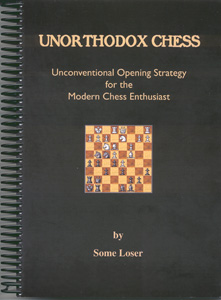
Yes, you read it correctly - the author of this recently-released book is given as 'Some Loser.' It would be easy to dismiss such a work out of hand; however, I will try to present a more detailed opinion.
This monograph, measuring some 8 by 10 inches, consists of 369 pages, spiral bound with soft covers. It is produced by Trafford Publishers, an internet-based vanity publisher with offices in Victoria (B.C.), Crewe (England), and Drogheda (Ireland). The asking price is a hefty $125 Canadian. Subtitled 'Unconventional Opening Strategy for the Modern Chess Enthusiast,' the book consists of three chapters: Conventional Opening Strategy, Passive Aggression, and Subterfuge.
Chapter One contains "some sample games and analyses of mainstream chess openings in which I'll present my favourite lines and pet variations, including valuable improvements and novelties, which can be reasonably well relied upon to yield satisfactory results if not mishandled." Turning to the first game one finds 1.e4 e5 2.c3 Nf6 3.f3; there are samples of standard openings (Giuoco Piano, Cochrane Gambit in the Petrov's, 2.c4 against the Sicilian), but the author goes on to examine literally every legal first move, including 1.a4 and 1.h4. Some of the improvements and novelties include playing 1.e4 e5 2.Nf3 Nf6 3.Nxe5 Qe7! in the Petrov Defence (according to the author the normal 3...d6 is dubious as it is refuted by -- the Cochrane Gambit!), and 1.e4 e5 2.Nf3 Nc6 3.Nc3 Nf6 4.a3!?, which the author claims as a novelty but which was played by Gunsberg, Maróczy, Tarrasch, and Nimzowitsch, and is featured in Secrets of Opening Surprises by Jeroen Bosch.
In Chapter Two the author describes a style he terms passive aggression. This is the 'give a man enough rope' school of chess - "start off by playing extremely cautiously and conservatively so as to offer no advantages or tactical opportunities to your opponent, while being always on the alert for opportunities to take advantage of any mistakes or oversights on his part." He states this approach is commonly referred to as the Hedgehog or Hippopotamus, yet nowhere in the chapter do we find examples of the Hedgehog (itself a perfectly legitimate mainstream opening). Instead, the author advocates a particular formation, e.g., for White: 1.g3 2.f3 3.e3 4.d3 5.Nh3 6.Nf2 7.Bg2 8.O-O, followed by either 9.Re1 10.Nd2 11.Nf1 or 9.Qe2 10.Rd1 11.Nd2 12.Nf1. This can also be played in mirror image on the queenside, or with the Black pieces.
Chapter Three approaches "the limits of eccentricity," presenting opening moves designed to shock and/or goad the opponent into lashing out. These include simply developing and undeveloping the knights several times, the now infamous 1.f3 2.Kf2, and the author's "ultimate deadly secret weapon," 1.e4 Nf6 2.e5 d5!? (the 'Trojan Gambit').
In each chapter the author's method is to give a short prose introduction to the given subject, followed by numerous sample games, divided into sections for White and Black. In total I would estimate there are some two thousand games in the book, mostly given without annotation or with only a few symbols or brief notes; only occasionally is a position analyzed in detail. The only diagrams are on the first page of each chapter, there are none included elsewhere. No information is given about the games - names of players, ratings, events, dates, time controls, etc. are all missing. Given the quantity of the games and the type of formation espoused in chapter two I would guess many of them were played against computers or on the internet, but there's no way of knowing that. Some of the games are identifiable, and in six games from one tournament four of the game scores have been altered: a resignation instead being played out to mate, a drawn game changed to produce a win for one of the players, and two losses now resulting in two wins. Six games is obviously a very small sample from the two thousand-odd games given, but as white wins every game in the White Sections and black wins every game in the Black Sections (no draws at all!), I suspect this practice is fairly widespread.
The author has chosen to use a pseudonym; he presumably has his reasons for doing so which I will respect. However, a writer's playing strength is an important criterion when considering a chess book, so I will reveal his peak rating was around 2100 (CFC), and his success was due more to his own defensive skill in bad positions rather than the inherent worth of the opening systems he recommends. The author has obviously put a lot of time and effort (and money!) into producing this book; a collection of annotated games and anecdotes by a local player might have been of interest, but unfortunately as an openings manual Unorthodox Chess is a travesty. For the same cash outlay one could purchase all three volumes of Bosch's Secrets of Opening Surprises series, and still have change left over.
CHESS ON THE EDGE: A PRE(RE)VIEW (first published in BCCF Bulletin #138, 19 February 2008)
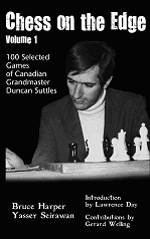
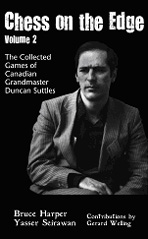
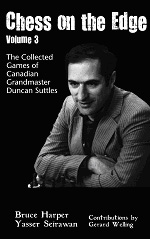
These are halcyon days for anyone interested in Canadian chess literature. Last year saw the publication of Nick's Best, a collection of games by IM Bryon Nickoloff; now, Bruce Harper's long-anticipated book(s) on Duncan Suttles, Chess on the Edge, is currently at the printers and will be available in about a month. The following review is based on the computer files from which the books will be published (by the Chess 'n' Math Association, who coincidentally also produced Nick's Best).
One of my fields of study at university was musicology (in its broadest sense, the study of music). Leaving aside the practical disciplines of composition and performance, there are two main subdivisions to the academic study of music - history and theory. Music history concentrates on the relationships between works of art, what influenced the composer, how the music was received within society at the time, and so forth. Music theory concentrates on the work of art itself - its form, structure, how it works.
If chess were equated with music, the Suttles books would fall into the realm of music theory. The emphasis is on the games themselves, to a large degree taken out of their historical context. There are no crosstables presented, no tournament records. The one-page biography is almost perfunctory in its shortness; for those seeking insight into Suttles the man, the five-question interview will not add to their understanding. But this misses the point: Chess on the Edge is not intended to be a historical work. Instead, it seeks to elucidate the games and chess style of a Canadian chess legend.
Co-authored by Bruce Harper and Yasser Seirawan, and with contributions by Lawrence Day and Dutch IM Gerard Welling, this obvious labour of love is divided into three volumes. Volume one presents one hundred of Suttles' games, heavily annotated and organized by theme. These introduce and demonstrate various aspects of Suttles' style, which the authors acknowledge to be "murky" and often difficult to comprehend. The remaining two volumes contain all of Suttles' other extant tournament games, organized by ECO code and annotated, along with the first ten moves of each game contained in volume one. There are also a total of fourteen supplemental games (i.e., not played by Suttles) scattered through the three volumes. While obviously designed as a set, the first volume stands alone as a games collection complete in its own right; for those wishing to enter the "Twilight Zone" of volumes two and three, acclimatization via the first volume is strongly recommended.
The Prologue states that the "main goal of the first volume is to help the reader understand Suttles' unique style, but there may be instructional or inspirational value in this volume as well." This is quite an understatement. Yes, the elements of Suttles' style are examined, but there is also much discussion of standard middlegame themes, along with references to military history and flights of a philosophical nature. In one sense the volume can be viewed as a case study, one specific answer to the question "how does one win a game of chess?" Since the time of Steinitz it has been accepted that to win at chess, the opponent has to make a mistake. How is this to be accomplished? Sometimes errors are unforced, but more often the opponent has to be pressured, or given the opportunity to go wrong. One way of doing this is to take the opponent out of his comfort zone, to present him with new and unfamiliar problems to solve. In the Kasparov age of computer-assisted preparation this consists of producing novelties between moves fifteen and twenty-five or so; Suttles adopted a more radical version of the same approach, producing 'novelties' in the first few moves of a game, or psychologically-unhinging his opponents with weird maneuvers. This doesn't mean that Suttles was always successful - the experiment could backfire - but it's certainly fun to watch. [Incidentally, given that many players these days prepare using strong computer programmes, which play whatever works without a thought for aesthetics or perceived weirdness, one wonders whether current players are less 'freakable' than those of Suttles' time.]
The annotations themselves are lively and engaging. They are word and explanation oriented (which is not to say that deep analysis and variations aren't entered into when the position requires it), making the games accessible to a wide audience. This is also a practical necessity, since much of Suttles' chess is psychological in nature and unyielding to Informant symbols. Copious diagrams aid the reader's understanding. Volume one has a wonderful Foreword by Lawrence Day (one hopes he continues to publish his recollections), also two entertaining Prefaces by the co-authors. There are also two appendices; the first discusses the 'rat' nomenclature, the second the Suttles' System, which elsewhere has been referred to as the 'Great Snake.'
There are a few historical inaccuracies, including three on the biography page. We are told that Suttles was fifteen when he learnt how to play chess. Given that he turned fifteen in December of 1960, this would make his participation in the 1961 Canadian Championship rather miraculous. Instead, CCCA Bulletin #299 (April 1962) has a short autobiographical note from Suttles ("I am 16 years old and began playing chess 2½ years ago.") This would make him thirteen at the time he took up chess. The biography states that Suttles' 1981 comeback event (in which he tied for first with Tony Miles) was the Western Canadian Open, when in fact it was the FIDE-rated International which followed the WCO. Also, Suttles' last tournament game wasn't against Tyler Johnson in the 1984 Vancouver Futurity, but versus Fatos Muço at the Thessaloniki Olympiad later that year.
The Encyclopedia of Chess Openings is referred to throughout the three volumes, but we are rarely told which edition has been consulted (the five volumes of ECO have been revised between three and five times each, and vary considerably between editions). Citation of previous published annotations is variable: Informant volume numbers are invariable given, or month and year for Chess Canada. But for other sources (Canadian Chess Chat, Northwest Chess, B.C. Chess Reports), the date of publication is generally lacking, and in some cases an author's annotations are mentioned without any citation.
The volumes are provided with player indices, while volume three also includes an event index. The main tournament heading is by location, which means that local events (unless they happen to be a championship of some sort) are lumped together under one heading without further differentiation. Unfortunately one of B.C.'s most famous tournaments is called Vancouver 1975, which makes it impossible to determine which of the eleven games listed in the index are from that specific event (for the record, the games versus Tjebbes, Chow, and McLaren are from the Labour Day Open, that against Oszvald from the B.C. Open). The indexing of the supplemental games seems to have a strange effect - the listings for B. Harper are particularly bizarre. As noted earlier, volumes two and three are arranged by ECO code. When there is a reference to another Suttles game as part of the annotations, one is given the standard game header but not the page where the game can be found. This makes it a little difficult to find the referred game: either the section with that ECO code has to be browsed (and some of them, e.g., B06, are rather large), or the index has to be consulted.
American spelling is used throughout, which this reviewer finds strange for a book published in Canada about a Canadian icon. The occasional typographical error does not detract from the overall readability of the text. There is a section of photographs, and two line drawings of rats by Laura Harper. At this point I can't comment on the overall production values or binding (hard cover), but judging by the wonderful job the Chess 'n' Math Association did on Nick's Best, there shouldn't be any problems in that regard.
Despite these minor quibbles, Chess on the Edge is a worthy addition to the (growing) literature on Canadian chess. For Suttles' afficionados and those interested in chessic Canadiana all three volumes will be required reading; for the rest of the world, volume one stands on its own as a games collection and instructional work, while the other two volumes might be more of an acquired taste.
BULLET CHESS (first published in BCCF Bulletin #176, 28 October 2009)
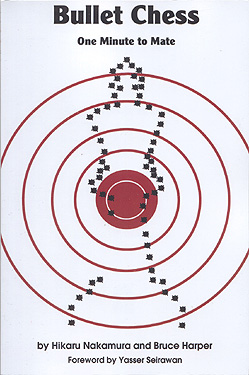
The last couple of decades have seen the rise of several tendencies which have had a profound impact on the game of chess. The rate of play has increased: traditional six-hour playing sessions have been eroded to five or four hours, while active chess (thirty minutes) has become common and five-minute blitz has given way to three minutes (at least online). The development of computers and the internet have allowed players to indulge in their favourite pastime at any time of the day and night and with opponents anywhere in the world, all without leaving the comfort of home. These tendencies have coalesced in bullet chess, an online chess game in which the time control is a mere minute per player. (It is possible to play bullet over the board, but use of a computer eliminates the inevitable insanity involving physical piece movement and clock handling with very limited time available. It should also be noted that ICC, one of the most popular online sites, defines bullet as any game with a time control less than three minutes, but the present work equates it with one-minute chess).
Playing a game in one minute may seem ridiculous to those of us who grew up with 40/2, 20/1, but it is possible, as long as one realizes that bullet is not the same as chess, a point the authors make explicit at the beginning of the book: "This is the fundamental truth about bullet chess that many players fail to understand. Bullet is certainly a form of chess, and much of what you've learned about chess applies to bullet, but bullet should never be confused with conventional chess itself!" To put it another way: five years ago GM Larry Christiansen wrote an article in which he compared chess with literature. Christiansen equated correspondence games with scholarly journals and epic novels; at the other end of the scale, he felt bullet games were on a par with comic books, grafitti, and chess columnists [sic]. In other words (and with apologies to any serious comic book collectors or grafitti artists reading this), he values bullet purely as entertainment. Nakamura and Harper concur - the only reason they give for playing bullet is "Because it's fun!"
This is the first book to be written on bullet chess, so for any interested party the only relevant question will be, "Is it worth acquiring?" The answer is an unequivocal "Yes!" The authors are no strangers to B.C. chess players: Hikaru Nakamura, current U.S. champion and sometime resident of Vancouver, is regarded as the world's best bullet player, while five-time former B.C. champion Bruce Harper needs no introduction from me. Together they guide the reader through all aspects of playing bullet chess - pre-moving, openings, the initiative, strategic and tactical considerations, endings, typical errors, and much more. Divided into twenty chapters, the breezy text includes many complete games and fragments to illustrate the points made. ECO codes are given for all examples, which seems a little odd in the case of the fragments. The games were all played on ICC at one minute per player; names have been omitted to protect the guilty (although handles are almost universally used online, so players are usually anonymous anyway), but we are told that many of them were played by former Canadian Junior champion Tyler Johnson. The ratings of the players are given, in the range 1700 - 3000+; likely any player above 2800 is Nakamura himself. A significant thread through the entire book is the fine balance that must be maintained between the position on the board and the time left on the clock, there is also much emphasis on the psychological aspects of play.
Physical attributes: roughly six inches by nine, two hundred and forty-eight pages, soft cover, copious diagrams, high production values by Russell Enterprises. The cover price is $19.95. There is no index, but the chapter headings should be sufficient to locate specific topics. Foreword by Yasser Seirawan. The book is written entirely from the human perspective, so there is no advice on how to play bullet against computer progams (assuming people engage in such a masochistic endeavour). Technical matters are also not addressed, such as the different computer interfaces available or dealing with lag. Nakamura and Harper rightly emphasize the fun aspects of bullet, but in so doing perhaps present an overly rosy view of the online community. My own experience is that there are more than a few who approach bullet too intensely - they would be wise to read the very last paragraphs in the book, "A word on etiquette."
Recommended for anyone who has an interest in chess in the fast lane.